The exceptional discovery of the ship-grave of Sutton Hoo (United Kingdom), in 1939, is the central theme of the film "The Dig" currently broadcast on Netflix. An excavation that has upset what we know of the "Dark Ages", the British High Middle Ages.
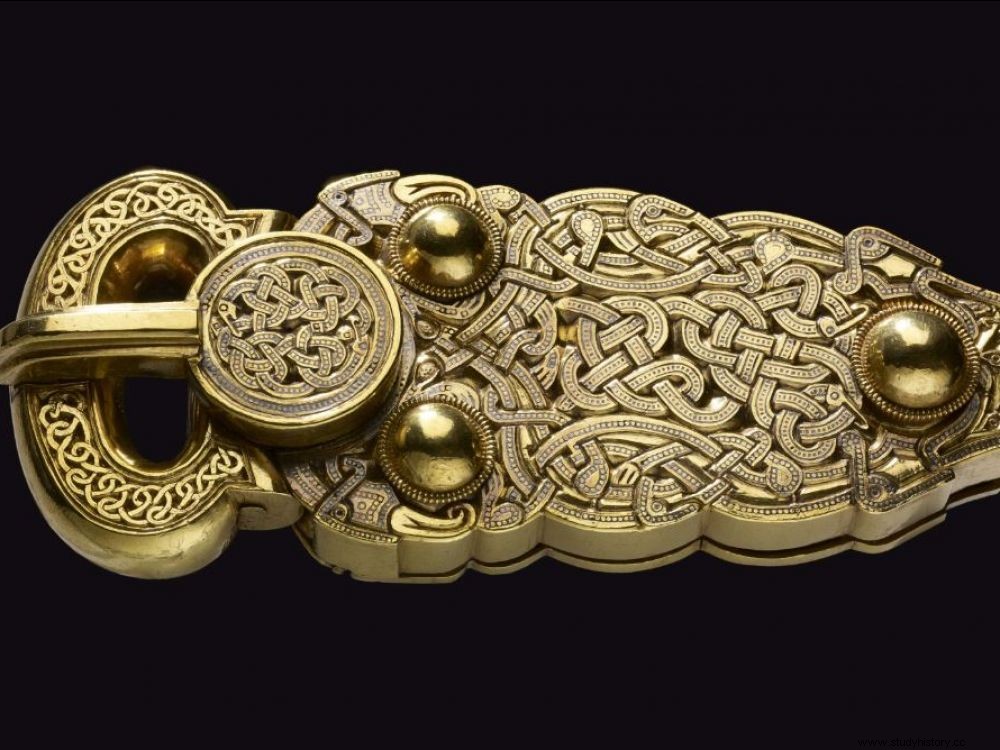
Gold belt buckle, a masterpiece of 7th century craftsmanship, with intricate decorations of intertwined creatures.
Netflix broadcasts since January 29, 2021, The Dig (the excavation), which romantically tells the story of the spectacular discovery by archaeologist Basil Brown of the site of Sutton Hoo, on the banks of the River Deben, in Suffolk on the east coast of England. One of the most fascinating archaeological discoveries of the 20th century. Adapted from John Preston's novel (2007), this film directed by Australian director Simon Stone starring Ralph Fiennes in the lead role, explores the unearthing of a Grave Ship, a 7th century Anglo-Saxon burial vessel . This is what Sue Brunning, curator of European collections from the early Middle Ages, recalls in a publication from the British Museum in London.
The footprint of the boat grave at Sutton Hoo (Suffolk) discovered in 1939. Credits:Twitter
Indeed, the Sutton Hoo tomb is that of a powerful figure whose extraordinary treasure has stunned researchers:in the collapsed burial chamber found in 1939 appeared a priceless array of 263 objects, ranging from a spectacular from ceremonial iron decorated with combat scenes, to shield ornaments and precious pieces of silverwork with Celtic, Anglo-Saxon and Mediterranean influences. A gold belt buckle intertwined with foliage, coins from Merovingian France, and a maple wood lyre were also among the precious objects found. So many discoveries that have transformed the knowledge that specialists had of England's medieval past, this period stretching from the 5th century (after the withdrawal of the Romans) until the 10th century (arrival of the Vikings). Those that the British have long referred to as "Dark Ages" or even "Dark Ages".
The excavations of Sutton Hoo, in Suffolk (England) in 1939, and the images of the film "The Dig". Credits:Twitter
However… far from these dark qualifiers, the objects unearthed at Sutton Hoo testify to incredible exchanges over long distances. The garnets adorning the iron helmet and those on a gold-leaf reinforced cloisonne shoulder strap were found to originate in Sri Lanka, in the Indian Ocean; a silver tray comes from Constantinople, the capital of the Byzantine Empire; pellets made of a particular type of bitumen collected from the ship originated in the Near East, and probably Syria, as did fragments of textiles. A whole treasure that can be admired today in the British Museum, in London.
The conditions for the discovery of the boat-grave
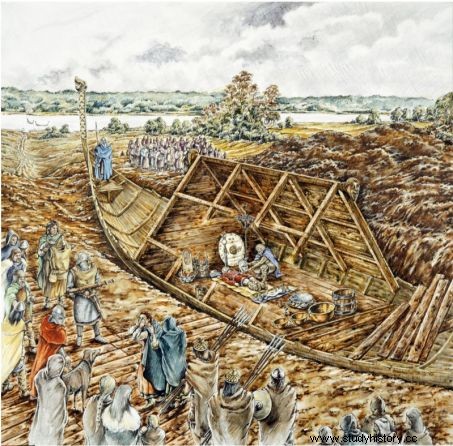
Reconstruction of the ship's burial at Sutton Hoo (Suffolk), a royal tomb in Anglo-Saxon England. Probably the burial of King Raedwald, ruler of the kingdom of East Anglia, in the 7th century. Credits:Sipa
It was therefore on the eve of the Second World War - the twilight in which the film was shot seeming to announce its imminence - that Edith Pretty, owner of a vast estate located at Sutton Hoo, (1883-1942 ) - played by actress Carey Mulligan - ponders the presence of high mounds of earth covered by a thin carpet of grass. Intrigued, this enlightened amateur of archeology, who has already visited many sites including Pompeii (Italy), Athens (Greece) or the Pyramids of Giza (Egypt), will ask for help. She contacts a local self-taught archaeologist, Basil Brown (1888-1977 - played by Ralph Fiennes), to carry out the excavations. The Dig will then begin. For this amateur with a reserved personality, the study of the first mounds, in 1938, will be somewhat disappointing because they have already been looted over the centuries. But everything will change in May 1939. As the world is on the verge of entering a second world conflagration, Basil Brown attacks the largest of these mounds, inviolate this one. In a few days, the stigmata of a 27-meter-long ship appear, the wooden planks of which have disappeared, eaten away by the acidity of the sediments. Only the rows of rivets and the imprint of the ship's hull still permeate the earth. The "Eureka moment" takes place on July 21, 1939, when the remains of a burial chamber are found, filled with magnificent treasures!
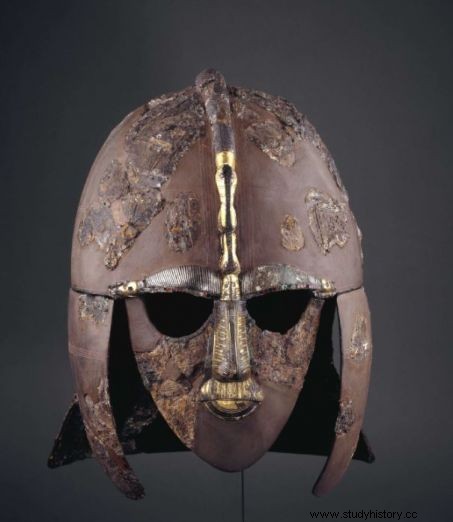
The Sutton Hoo helmet is one of only four surviving complete Anglo-Saxon helmets. Its facial decoration would be that of a dragon whose wings would form the eyebrows. Credits:SIPA
The excavations completed, the owner donated the Sutton Hoo treasure to England
At the time, no bone remains were reported. Traces of bones will only be identified in the years 1963-1971, when new excavations will be undertaken, confirming that a body has indeed been laid there. But whose was it? Undoubtedly a king, the only one to be able to benefit from such a sumptuous burial. Yes, but which one? Thanks to the writings of the Venerable Bede (around 672-735) evoking such an event, the hypothesis has been put forward that it could be King Raedwald of East Anglia. This high personage was part of a dynasty originating in Sweden, which arrived in England around 500. The date of the death of this sovereign - around 624 - could indeed correspond to the dating of these remains. However, the real identity of the deceased from Sutton Hoo still remains uncertain.
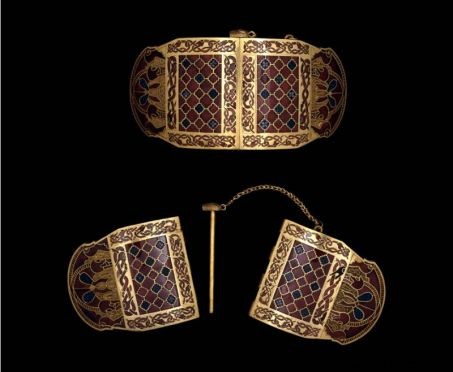
Cloisonné shoulder straps, a goldsmith technique that applied to metal jewelry supporting semi-precious stones, like these garnets. Credits:SIPA
The film also depicts the relationship between Basil Brown and the licensed archaeologists from the University of Cambridge officially mandated to work on this treasure. In particular Charles W. Phillips (1901-1985) – played by Ken Stott – a kind of Mandarin who immediately tries to keep him away. The film translates well the clash of classes in an England with a society that was then quite divided. The excavations completed, Edith Pretty - who was the owner according to the law in force - donated the treasure of Sutton Hoo to England. As the war approached, the objects were immediately hidden in a disused section of the London Underground, between Holborn and Aldwych stations, in order to protect them from raids by German aircraft.
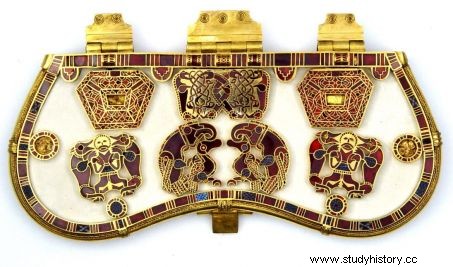
Lid of a handbag used to attach a leather pouch, which contained Frankish gold coins. Credits:SIPA
Since the discovery of the site in 1939, each new analysis carried out on the objects coming from Sutton Hoo does not cease to bring its batch of information. Thus in 2014, for example, an article in the Journal of European Archeology indicated that examination of the iron helmet revealed that the 25 garnets encrusted above the left eye did not sparkle as brightly as the brighter ones in the right eye. Specialists have deduced that this could be understood as a reference to one-eyed Odin, the god of war but also of knowledge, who according to legend, had agreed to sacrifice his left eye to be able to drink from the well of wisdom! Today, there is no longer any doubt that the site of Sutton Hoo and its 18 mounds form a necropolis of the Anglo-Saxon elite. A remarkable discovery that this film tells in a style far from the clichés usually conveyed by the cinema. The Dig or the antithesis of Indiana Jones movies. To watch without moderation.
